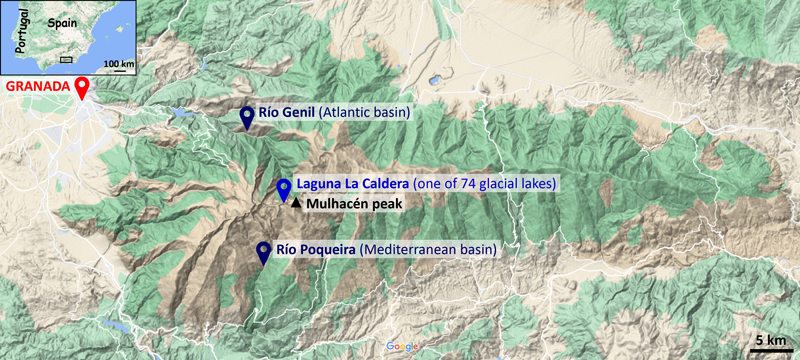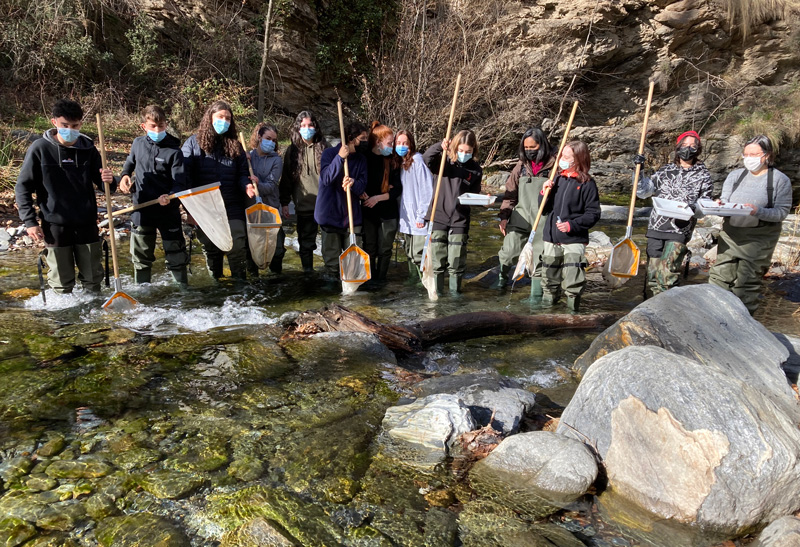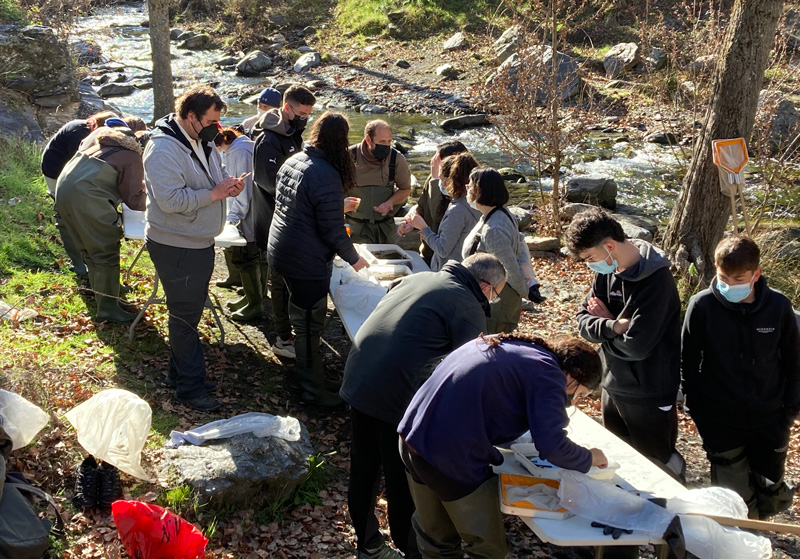Throughout human history, the waterscape has transformed us, and in turn, we have altered it. The Mediterranean features some of the oldest humanized landscapes in the world. There, farming communities took shape in areas such as Spain’s Sierra Nevada (“snowy mountains” in English). In these regions, scarce rainfall at low elevations supplemented by water flowing from “mountain water towers” (snowmelt and rainfall reserves stored in mountain ranges) supported a mix of farming and pastoral lifestyles. Arguably, this working societal contract with water eventually diffused to societies across the world [Boccaletti, 2021].
Today, multiple stressors are endangering this ecocultural contract with water. Such stressors, including rural exodus, urbanization, changing land use, and intensifying climate swings, make the waterscape the most altered of all of Earth’s major biogeochemical cycles.
Around the world, freshwater resources, and the myriad of ecosystem services they provide, are becoming increasingly critical under the combined assault of anthropogenic and climate change impacts. Such impacts are most visible for mountain water resources that are the source of most of the world’s streams, lakes, wetlands, and major rivers—the natural “water towers” of the world [Viviroli et al., 2007; Immerzeel et al., 2020].
Here we highlight the plight of Sierra Nevada water resources in Spain, along with education and conservation steps being taken to protect this vital peninsular resource.
The World’s Water Towers
About half of humanity depends on mountain water towers (MWTs) for everyday household consumption, farming, industry, and quality of life. However, because MWTs are particularly sensitive to intensifying anthropogenic impacts and ongoing climate change—high-altitude ecosystems are warming faster than the global average, for example [Intergovernmental Panel on Climate Change (IPCC), 2021]—both mountain ecosystems and downstream communities face increasing water-related uncertainties.
Mountains cover some 27% of Earth’s surface and provide more than 50% of the world’s freshwater resources.
Mountains, which cover some 27% of Earth’s surface, provide more than 50% of the world’s freshwater resources. MWTs play a vital role because of their worldwide distribution, coupled with an immense capacity for intercepting, capturing, and storing precipitation and distributing it to lowlands. Mountains that are glaciated and periglaciated (having subterranean ice reserves) can even out wet and dry periods by holding water in reserve in winter and releasing it during subsequent dry and hot summer months [Huss and Hock, 2018; Immerzeel et al., 2020].
Water from MWTs is even more critical in dry regions such as the Mediterranean [Viviroli et al., 2007; Food and Agricultural Organization of the United Nations (FAO), 2012]. Mountain lakes, streams, and rivers also sustain numerous fragile ecosystems such as riparian forests and biodiverse wetlands in their watersheds [FAO, 2012]. However, both the quantity and quality of mountain waters, the ecosystems they sustain, and the services they provide are increasingly threatened by climate change (e.g., warming; extreme droughts and floods; reduced rain, snow, and ice or their increasing loss), unsustainable land use and water extraction, and ongoing pollution. All these factors endanger the attainment of the U.N. Sustainable Development Goal of Clean Water and Sanitation [United Nations, 2021], which aims to provide universal and equitable access to safe and affordable drinking water, sanitation, and hygiene by 2030.
Sierra Nevada Mountain Water Resources
The Sierra Nevada is Europe’s southernmost glacial mountain range (Figure 1), with 15 peaks higher than 3,000 meters (the highest being 3,479 meters). It stretches across some 2,273 square kilometers in southern Spain, and its watershed encompasses multiple Mediterranean bioclimates along its altitudinal and latitudinal extent. The Sierra Nevada contains 74 glacial lakes, and it is the source of hundreds of streams and several major rivers. For example, the watersheds of the Río Genil and Río Poqueira end in the Atlantic Ocean and Mediterranean Sea basins, respectively.

Today, parts of the Sierra Nevada are included in the Sierra Nevada National Park system, and the entire range is a U.N. Educational, Scientific and Cultural Organization biosphere reserve. These mountains, located across the Mediterranean Sea from the African continent, experience pronounced interannual variability in climate, including moderate winter conditions and frequent, severe droughts. Although the last permanent glaciers of the Sierra Nevada melted away at the turn of 20th century, ice and snow cover still occur in the highest reaches for much of the year, and substantial reserves of periglacial ice persist, enabling the Sierra Nevada to sustain a diverse array of ecosystems [Zamora and Oliva, 2022].
The mid-March 2022 event turned the skies over Europe red, parts of southern Spain were drenched in mud rain, and the snow on the Sierra Nevada turned brown.
The Sierra Nevada range receives Saharan dust on a regular as well as episodic basis. The dust fertilizes the water and soil of this Mediterranean ecosystem with key nutrients such as iron, calcium, and phosphorus. Some transcontinental dust events can be massive: The mid-March 2022 event turned the skies over Europe red, parts of southern Spain were drenched in mud rain, and the snow on the Sierra Nevada turned brown.
Just as mountains intercept rain clouds from moving air masses, they disproportionately intercept dust circulating in the free troposphere, relative to flatlands in the landscape. (The free troposphere is above the planetary boundary layer, about 1,700 ± 500 meters above sea level.) Further, dust lowers the albedo of snow, ice, and water. This change in albedo warms snow and ice and enhances its melting, which affects the water cycle of the Sierra Nevada and its watershed [Zamora and Oliva, 2022].
Even though different mountain ranges of the world experience climate change and anthropogenic impacts differently, there are common ongoing effects, such as depleting MWTs and degrading mountain and downstream ecosystems. We have observed long-term (decadal) trends in changing conditions (decreasing annual precipitation, increasing warming, snow loss, pollution, etc.) in time series observations from the Sierra Nevada Global Change Observatory.


These trends are in step with increasing ice loss in lakes across the Northern Hemisphere and reduced winter ice that leads to increased interannual variability in water flow. In recent years, southern Spain has been experiencing increasingly milder winters, hotter springs, and summers that include heat waves.
Additionally, water quality in the Sierra Nevada watershed has deteriorated over the past few decades, in sync with increased human appropriation of water and recurring drought events. Many of these watershed observations, made on the mountains and in downstream locations, generally mimic those taking place in mountain ecosystems globally (the Andes, Rockies, Himalayas, etc.). Concurrent loss of glacial and periglacial ice is a looming problem across the world, and it affects water availability, water quality, and biodiversity [IPCC, 2021].
Education and Conservation in the Sierra Nevada
Currently, researchers at the University of Granada coordinate two innovative projects covering high mountain lakes, streams, and rivers in Spain’s Sierra Nevada watershed. These projects, which involve students and community members, broaden youth participation and inform the public about the intrinsic value of water in their everyday lives and the need for its protection and conservation [Zamora and Oliva, 2022].
In one program, Ríos de Vida (Rivers of Life), high school students who live in different parts of the Río Genil basin work in partnership with the university. The students chronicle changes in the ecology and health in the stretches of the river closest to them as it runs from the mountains through Granada, a city of 300,000 people, and other communities on its way toward the sea. At the end of the school year, they all gather for a conference to share data and discuss their observations.

On the whole, there are 13 active river renaturalization projects underway in Spain that aim to restore biodiversity and natural hydraulic flows in the watershed. However, these efforts are mostly focused on downstream and urban stretches of the rivers, where strong environmental consciousness prevails among urban communities.
The project focuses on extending environmental protections and restoration practices to the mountain headwater ecosystems, which have received less attention than regions farther downstream.
The other project coordinated through the University of Granada, 74 High Mountain Glacial-Lake Oases, focuses on the headwater regions of the Sierra Nevada’s rivers. This community science campaign has made a good start by involving all segments of the public and stakeholders. The project focuses on extending environmental protections and restoration practices to the mountain headwater ecosystems, which have received less attention than regions farther downstream.
The headwaters are where the water towers primarily recharge and sustain sensitive mountain biodiversity (high-altitude wetlands and other flora and fauna endemic to mountain ecosystems) and provide numerous downstream ecosystem services. Project participants—everyone from hikers and scientists to farmers and city managers—keep their eyes on the 74 glacial lakes of the Sierra Nevada by sharing images of and notes about the lakes.
Because the ways that people use and misuse water are closely tied to how they value it, such community science projects can spur wider engagement and implementation of sustainable water policies. This engagement is becoming increasingly important because many parts of the world with Mediterranean climates, including California, Chile, southern Africa, and southern Australia, are experiencing critical water shortages and deterioration of water quality. These problems are attributed to a succession of episodic and intensifying droughts and exponentially rising water demands, along with the resulting concentration of existing pollutants. The situation is particularly critical in the southwestern United States and Chile (regions undergoing megadroughts) and in the Spanish Sierra Nevada region, which is experiencing its worst drought on record.
The Future of Mountain Water Towers
The world’s MWTs are rarely valued as strategic water reserves, even though they help to ensure steady annual flows of water that affect nearly half of humanity. These water reserves even out changes in water supplies by capturing and freezing vast quantities of water during the winter months and releasing them during warmer summer months.

Periglacial water represents one important gap in our knowledge. The combined action of glacial and periglacial water is fundamental to the provision of water to streams, rivers, and water tables in the watershed. Knowledge of periglacial water pools and fluxes is key to adapting to a world where all continental glaciers are fast disappearing. We hope that the recently operational Gravity Recovery and Climate Experiment Follow-On (GRACE-FO) satellite, which makes sensitive measurements of belowground gravity anomalies, will shed light on the size and turnover of this hidden component of the world’s MWTs.
As groundwater depletion continues unabated around the world, the value of mountain water towers to the water balance of downstream societies and ecosystems can only increase.
As groundwater depletion continues unabated around the world, the value of MWTs to the water balance of downstream societies and ecosystems can only increase. It is time that MWTs receive their due protection at both the watershed and global scales. In this context, there is encouraging news that the Spanish government is preparing to extend protection to 41 aquifers in the Iberian Peninsula, with 7 of them located in the province of Granada, which includes the 74 glacial lakes of the Sierra Nevada. Preserving mountain water towers is our best insurance policy for ensuring a steadier water supply and damping the growing tendency for floods and droughts as the climate increasingly warms and the water cycle wobbles ever more.
Acknowledgments
This work was supported by a Fulbright Fellowship at the University of Granada to B.B. and LifeWatch project “Smart EcoMountains” (LifeWatch-2019-10-832 UGR-01) and Ministerio de Ciencia e Innovación project “REMOLADOX” (PID2020-118872RB-I00) to M.V.-A. and J.M.-S. We are grateful to the participants (students, teachers, volunteers, and colleagues) involved in the two community science projects.
References
Boccaletti, G. (2021), Water: A Biography, Pantheon Books, New York.
Food and Agriculture Organization of the United Nations (FAO) (2012), International Mountain Day, www.fao.org/forestry/internationalmountainday.
Huss, M., and R. Hock (2018), Global scale hydrological response to future glacial mass loss, Nat. Clim. Change, 8, 135–140, https://doi.org/10.1038/s41558-017-0049-x.
Immerzeel, W. W., et al. (2020), Importance and the vulnerability of world’s water towers, Nature, 577, 364–369, https://doi.org/10.1038/s41586-019-1822-y.
Intergovernmental Panel on Climate Change (IPCC) (2021), Climate Change 2021: The Physical Science Basis. Working Group I Contribution to the IPCC Sixth Assessment Report, Cambridge Univ. Press, Cambridge, U.K., www.ipcc.ch/report/ar6/wg1/.
United Nations (2021), The sustainable development goals report, unstats.un.org/sdgs.
Viviroli, D., et al. (2007), Mountains of the world, water towers for humanity: Typology, mapping and global significance, Water Resour. Res., 43, W07447, https://doi.org/10.1029/2006WR005653.
Zamora, R., and M. Oliva (2022), The Landscape of the Sierra Nevada: A Unique Laboratory of Global Processes in Spain, Springer, Cham, Switzerland, https://doi.org/10.1007/978-3-030-94219-9.
Author Information
Bopaiah A. Biddanda ([email protected]), Annis Water Resources Institute, Grand Valley State University, Allendale, Mich.; and Manuel Villar-Argaiz and Juan Manuel Medina-Sánchez, Instituto del Agua and Departamento de Ecología, University of Granada, Andalucía, Spain



